This article has been reviewed according to Science X's editorial process and policies. Editors have highlighted the following attributes while ensuring the content's credibility:
fact-checked
reputable news agency
proofread
Explainer: Now-found door 'plug' may hold vital clues to how a gaping hole blew open on a jetliner
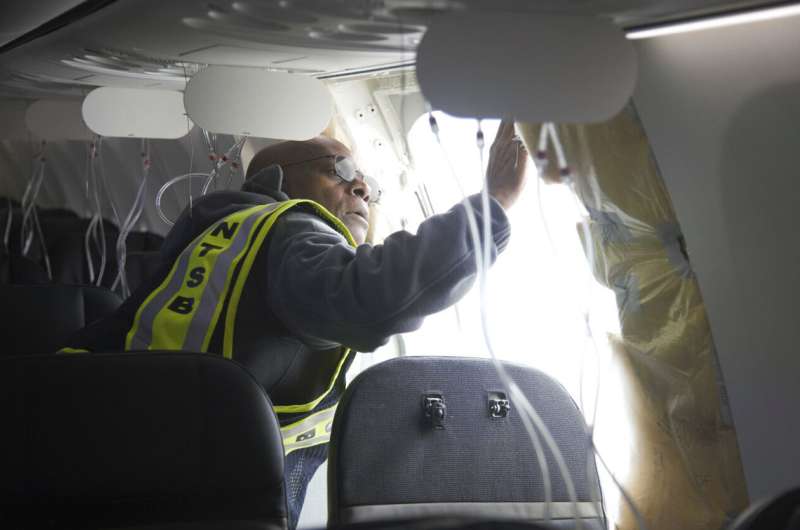
Investigators said Sunday they had found the piece of fuselage that blew off a Boeing airliner over Oregon on Friday, and hoped it would provide physical evidence of what went wrong.
The gaping hole in the side of the Alaska Airlines jet opened up where aircraft maker Boeing fits a "plug" to cover an emergency exit that the airline does not use.
The plugs are on most Boeing 737 Max 9 jets. The Federal Aviation Administration has temporarily grounded those planes until they undergo inspections of the area around the door plug.
WHY THE PLUG IS THERE
Some larger Boeing 737s have emergency exits on fuselages behind the wings to meet a federal requirement that planes be designed so passengers can evacuate within 90 seconds even if half the exits are blocked.
The more passenger seats there are on a plane, the more exits are required.
Some carriers, including Indonesia's Lion Air and Corendon Dutch Airlines, cram more than 200 seats into their Max 9s, so they must have extra emergency exits. However, Alaska Airlines and United Airlines configure their 737 Max 9s to have fewer than 180 seats, so the planes don't need the two mid-cabin exits to comply with U.S. evacuation rules.
On Alaska and United, the only two U.S. airlines using the Max 9, those side exits near the back of the plane are replaced with a permanent plug the size of an exit door.
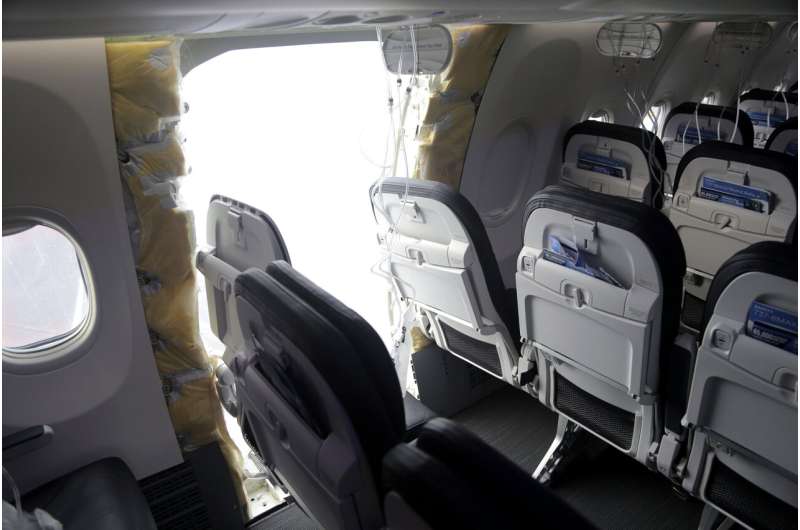
ARE THEY ONLY ON MAX 9s?
No. Boeing also makes bigger versions of its 737-900—a predecessor to the Max—and the Max 8 with space for extra exits in the back. Buyers of those planes also may opt to have either exit doors or plugs installed.
WHO INSTALLS THE PLUGS?
A spokesman for Spirit AeroSystems—which is unrelated to Spirit Airlines—confirmed to The New York Times that the company installed door plugs on Max 9s, including the plug on the Alaska Airlines plane involved in Friday's incident. The spokesman told The Associated Press that the plugs are assembled into 737 fuselages at Spirit's factory in Wichita, Kansas, but declined further comment.
Boeing declined to comment on the issue.
THE BOEING SUPPLIER
Spirit is Boeing's largest supplier for commercial planes and builds fuselages and other parts for Boeing Max jets. The company has been at the center of several recent problems with manufacturing quality on both the Max and a larger plane, the Boeing 787 Dreamliner. Last year, Boeing and Spirit AeroSystems discovered improperly drilled fastener holes in a bulkhead that keeps 737 Max jets pressurized at cruising altitude.
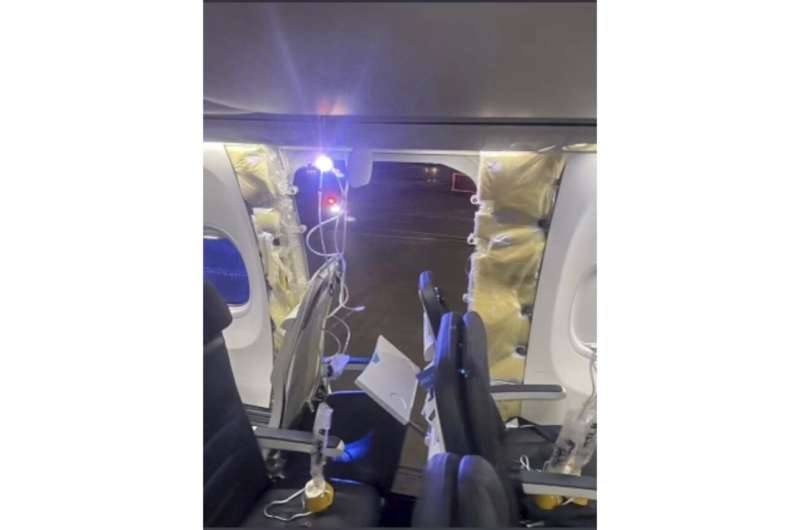
THE INVESTIGATION
Officials with the National Transportation Safety Board, led by the board's chair, Jennifer Homendy, arrived in Portland, Oregon, on Saturday to begin an investigation that is likely to last a year or longer. Homendy declined to discuss possible causes when she briefed reporters on Saturday night.
The NTSB team includes a metallurgist, and Homendy said investigators will look at the exit-door plug, as well as its hinges and other parts.
Examining the damage to the door will be crucial to the investigation, according to independent experts.
"The good thing about metal is that metal paints a picture, metal tells a story," said Anthony Brickhouse, who teaches accident investigation at Embry-Riddle Aeronautical University in Daytona Beach, Florida.
Brickhouse said the exit doors, whether plugged or not, are not necessarily a weak point in the fuselage. He had never heard of an exit door plug falling off a plane before Alaska Airlines flight 1282.
-
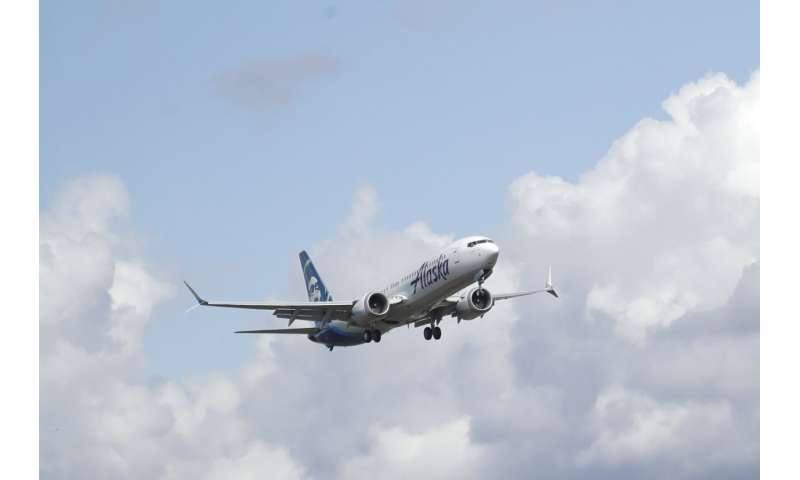
An Alaska Airlines Boeing 737-9 Max flies above Paine Field near Boeing's manufacturing facility in Everett, Wash., Monday, March 23, 2020, north of Seattle. A window panel blew out on a similar Alaska Airlines Boeing 737-9 Max seven minutes after takeoff from Portland, Ore., on Friday, Jan. 5, 2023. Credit: AP Photo/Ted S. Warren, File -

A sprawling hospital complex in the Cedar Hills neighborhood of southwest Portland, Ore., is seen from a patch of densely thicketed land across from it, Sunday, Jan. 7, 2024. The National Transportation Safety Board estimated that the fuselage of a Boeing 737 Max 9 that detached from an Alaska Airlines flight on Friday, Jan. 5, may have landed in the area. Credit: AP Photo/Claire Rush -

On a personal electronic GPS, Beaverton, Ore., resident Adam Pirkle shows the 14 miles he rode on his bicycle in his neighborhood and around southwest Portland, Ore., Sunday, Jan. 7, 2024, looking for the fuselage of a Boeing 737 Max 9 that detached shortly after the takeoff of an Alaska Airlines flight on Friday, Jan. 5. The National Transportation Safety Board estimated the fuselage may have fallen in the area. Credit: AP Photo/Claire Rush -
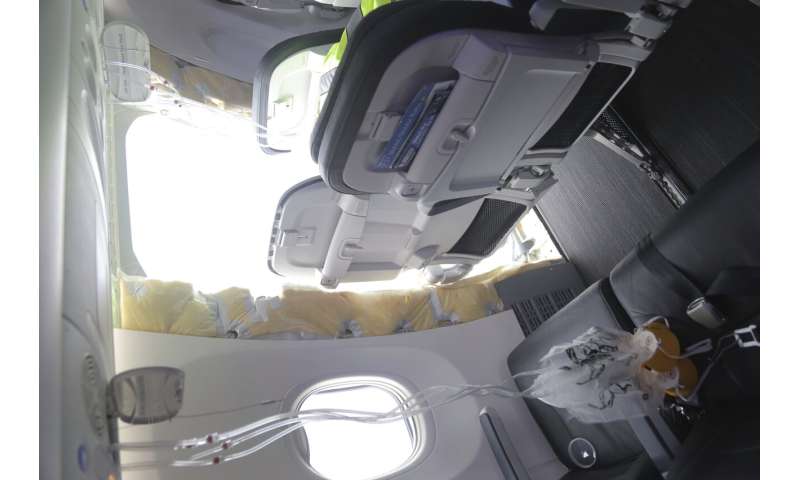
This photo released by the National Transportation Safety Board shows a gaping hole where the paneled-over door had been at the fuselage plug area of Alaska Airlines Flight 1282 on Sunday, Jan. 7, 2024, in Portland, Ore. A panel used to plug an area reserved for an exit door on the Boeing 737 Max 9 jetliner blew out Jan. 5, shortly after the flight took off from Portland, forcing the plane to return to Portland International Airport. Credit: National Transportation Safety Board via AP -
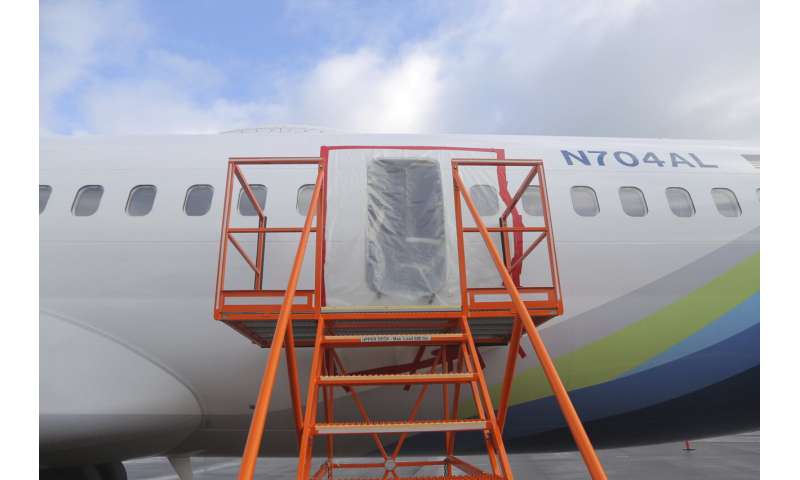
This photo released by the National Transportation Safety Board shows a gaping hole where the paneled-over door had been at the fuselage plug area of Alaska Airlines Flight 1282 on Sunday, Jan. 7, 2024, in Portland, Ore. A panel used to plug an area reserved for an exit door on the Boeing 737 Max 9 jetliner blew out Jan. 5, shortly after the flight took off from Portland, forcing the plane to return to Portland International Airport. Credit: National Transportation Safety Board via AP -
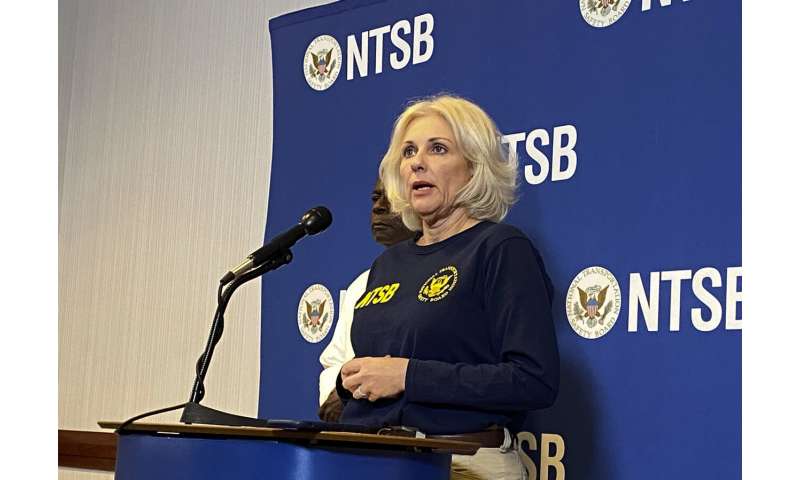
National Transportation Safety Board Chair Jennifer Homendy speaks at a press conference in Portland, Ore., on Sunday, Jan. 7, 2024. Homendy said the Boeing 737 Max 9 jetliner that suffered an inflight blowout over Oregon on Jan. 5 was not being used for flights to Hawaii after a warning light that could have indicated a pressurization problem lit up on three different flights. Alaska Airlines decided to restrict the aircraft from long flights over water so that if the warning light reappeared, the plane could land quickly. Boeing's 737 Max 9 jetliners are grounded while the airlines await instructions on how to inspect them. Credit: AP Photo/Claire Rush
WERE THERE WARNINGS?
The Boeing jetliner was not being used for flights to Hawaii after a warning light that could have indicated a pressurization problem lit up on three different flights, Homendy said Sunday.
Alaska Airlines decided to restrict the aircraft from long flights over water so that if the warning light reappeared, the plane "could return very quickly to an airport," she said at a news conference.
Homendy cautioned that the pressurization light might be unrelated to Friday's incident and more investigation was required.
OTHER FUSELAGE BLOWOUTS
There have been rare instances of holes opening in the fuselages of airliners. In most cases, they have been the result of metal fatigue in the plane's aluminum skin.
In the most horrific case, a flight attendant for Aloha Airlines was blown out of the cabin of a Boeing 737 over the Pacific Ocean in 1988 after an 18-foot-long (5.4-meter-long) chunk of the roof peeled away. Her body was never found. The tragedy led to tougher rules for airlines to inspect and repair microscopic fuselage cracks before they tear open in flight.
In 2009, a hole opened in the roof of a Southwest Boeing 737 flying 35,000 feet over West Virginia. And in 2011, a 5-foot (1.5-meter) gash unfurled in another Southwest Boeing 737, forcing pilots to make an emergency landing at a military base in Arizona. No one was injured in either of those cases, both of which were blamed on metal fatigue.
© 2024 The Associated Press. All rights reserved. This material may not be published, broadcast, rewritten or redistributed without permission.





















